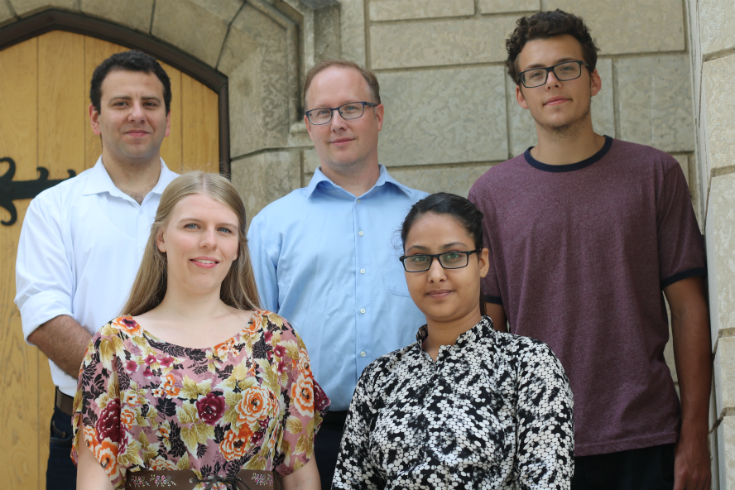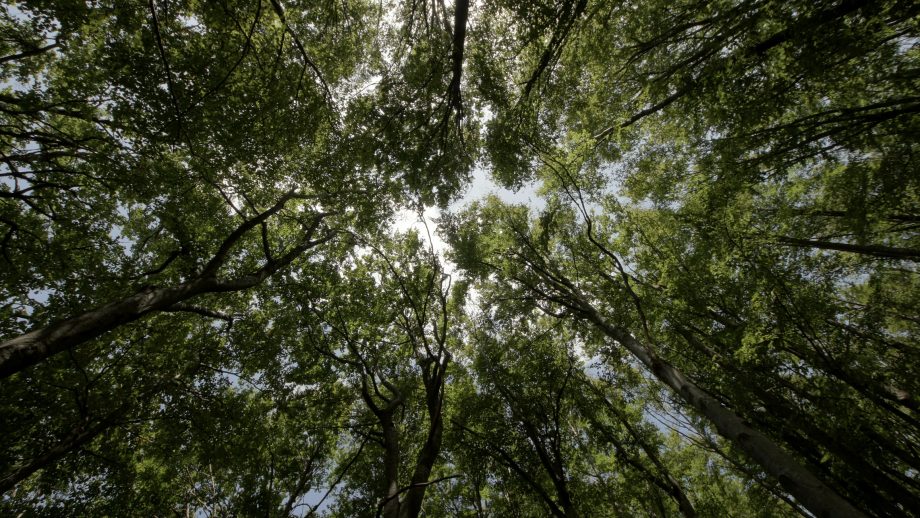
From left: Fady Shaker, Sarah Campbell, Dr. Blair Jamieson, Jashanjot Brar, Henri Sanness Salmon, ©UWinnipeg
UWinnipeg’s neutrino physics team, spearheaded by Dr. Blair Jamieson (physics), is collaborating on the Tokai to Kamioka (TK2)* project — an international neutrino experiment designed to investigate how neutrinos change from one flavour to another as they travel. The exciting result is that for the first time they have seen indications of a non-zero CP violating phase at the 95% (2 sigma) level.
Jamieson has been one of the conveners for the measurement of the electron-neutrino. His team includes undergraduate students Sarah Campbell and Henri Sanness Salmon, as well as graduate student Jashanjot Brar and PhD student Fady Shaker. Working with the TK2 team, they have collectively found, for the first time, that there are hints that the oscillations for neutrinos and anti-neutrinos are different. It is an exciting new hint that neutrinos behave differently than other particles and do not see large CP-violating effects**.
This difference could help explain why the universe appears to be made predominantly of matter, rather than an almost equal mixture of matter and anti-matter.
“One reason that this matters is, if it is confirmed by more data, that it could provide the needed asymmetry in behaviour between matter and anti-matter,” said Jamieson. “If the early universe started out as equal parts matter and anti-matter, then in this very dense initial phase of the universe, the CP-violation could have led to the abundance of matter over anti-matter that we now observe. The relevance is one of pure discovery of one of the elements to unlocking the story of how the universe itself came to be.”
About the students
Sarah Campbell recently returned from TRIUMF, Canada’s National Laboratory for Particle and Nuclear Physics. She has been doing an optimization study for reflectors in the multi-photomultiplier tube arrays that are being planned for a new near detector concept called nuPRISM. She just graduated from UWinnipeg with a BSc in a double major in math and physics.
“I am honoured to be working on a collaborative project which is conducting cutting edge research in physics. I think many people have this idea that a physicist does research alone all day, but often it is not actually like that. You are constantly in communication with other people, sometimes across the world, working together to solve problems and keep up to date on each other’s progress,” Campbell said. “What I enjoy about doing research is the feeling that you are contributing to an increased global awareness and understanding of our universe.”
Henri Sanness Salmon has been studying the vertex activity of the electron neutrino interactions in the near detector to develop improved selections of the electron neutrinos. He ecently graduated with the gold medal for his 3-year BSc in physics and will be continuing his studies at the University of Minnesota next fall in Aerospace Engineering and Mechanics.
“To have the opportunity to work on the T2K experiment with Dr. Blair Jamieson is an honor. For a student to be able to contribute to the world leading neutrino experiment is a privilege,” Sanness Salmon said. “I believe that this research opportunity has helped me get more involved into today’s physics as well as challenged my critical thinking as I face obstacles in my research. In addition to this, I believe that this experience will help me greatly in my studies and acquiring research and job positions in the future.”
Jashanjot Brar is pursuing a MSc at UWinnipeg. She has been studying the timing calibration of nuPRISM, that will measure interactions of neutrinos with different flux spectra, which will be needed for measuring more the CP-violation of neutrinos to a higher precision.
Graduate student Fady Shaker’s PhD thesis is on a measurement of the cross-section, using T2K near detector data, that tells how often these electron-neutrinos interact with the T2K near-detector materials.
“I am very happy to be a part of this collaboration that conducts leading edge research in this fascinating science. Such an interesting result not only for neutrino physics but for particle physics and cosmology as well,” Shaker said. “CP-violation discovery in neutrino oscillation will teach us something new about neutrinos and will shed some light on the matter/antimatter asymmetry problem.”
* The Tokai to Kamioka (T2K) team consists of physicists from 59 institutions in 11 countries, including Canada. The T2K experiment is situated in Japan, where a beam of muon neutrinos is produced in the Japan Proton Accelerator Research Complex (called J-PARC), located in Tokai, Ibaraki prefecture, on Japan’s east coast.
** CP-violation, often just called CP, is the product of two symmetries: C for charge conjugation, which transforms a particle into its antiparticle, and P for parity, which creates the mirror image of a physical system – Wikipedia




